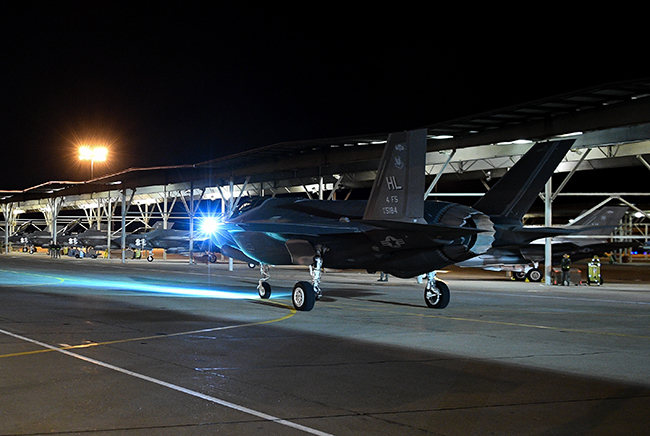
An F-35A taxis prior to departing from Hill AFB, Utah. Air Force photo by R. Nial Bradshaw.
The Pentagon should reconsider its operational requirements for the F-35 in light of the program’s struggle with reliability and maintainability, and expedite creating a business case for the Block 4 update of the jet before pursuing any more development contracts, the Government Accountability Office said in its annual review of the Joint Strike Fighter.
In the fourth of its congressionally mandated annual F-35 reports, the GAO said the program has made “slow, sustained progress” in improving reliability and maintainability, but is still only meeting half of its required metrics in this area. The watchdog agency said the Pentagon has not created specific improvement plans with “measurable objectives” and timelines, nor has it explained how it will make correcting these deficiencies a priority.
“If the R&M requirements are not met,” the GAO asserted, “the warfighter may have to settle for a less-reliable and more costly aircraft than originally planned.”
The GAO also reiterated its argument, which it has made several times before, that going ahead with Block 4 upgrade development contracts really ought to wait until the Pentagon has created a business case for the upgrade and conducted an “independent technology assessment” for it. The GAO noted that the first modernization development contracts are coming any moment, but the technology readiness assessment, independent cost estimate, and test and evaluation master plan for Block 4 aren’t expected to be done until October-December of this year. Consequently, the program won’t have a “high level of confidence” that risk has been appropriately reduced before committing to contracts. This in turn could lead to “cost and schedule overruns similar to those experienced by the original F-35 program during its development.”
Of the five recommendations in GAO’s report, four had to do with R&M. It suggested the Defense Secretary:
- Take another look at the operational requirements document for the F-35 to see if the R&M targets in it are “still feasible,” and if not, revise the ORD accordingly.
- Makes sure the F-35 program sets specific goals and timetables for the R&M improvement plan.
- Ensure the F-35 Joint Program Office identify and document which actions are expected to actually achieve the objectives set for them in the improvement plan.
- Ensure the JPO “prioritizes funding” for the R&M improvement plan.
- Hold off awarding any more development contracts, “at least for the initial Block 4 capabilities” until the independent cost and technology readiness estimates are done, and until there’s an approved test and evaluation master plan, “which addresses resources, aircraft shortfalls, and funding.”
The F-35 Joint Program Office concurred with four of the recommendations GAO made with respect to the program, disputing, however, that it’s too early to begin work on developing the Block 4 upgrade.
In a statement, the JPO said it’s already in the process of updating the reliability and improvement plans, and that these will spell out the details GAO was looking for; however, it disagreed with the fifth recommendation, saying the business case for Block 4 has been made.
“The program has adequate cost, schedule, and technical maturity knowledge to begin development,” the JPO said. The program baseline “contains Block 4 cost estimates and schedule milestones,” and the JPO expects the new program director will sign off on a Block 4 test and evaluation master plan in June, in anticipation of SecDef approval in the fall.
“Test sites have worked closely with the JPO and have the information and resources needed for near-term Block 4 test planning and execution,” the JPO said. It also said the technological maturity of Block 4 has been “assessed for system functionality and the JPO is currently establishing a process to continuously evaluate risk and technical maturity.”
Top Pentagon officials directing and overseeing the F-35 are expected to appear before the House Armed Services tactical aviation subcommittee on Thursday.